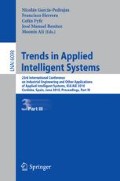Abstract
The main objective of this work is to automatically design artificial neural network, ANN, models with sigmoid basis units for multiclassification tasks in predictive microbiology. The classifiers obtained achieve a double objective: high classification level in the dataset and high classification level for each class. For learning, the structure and weights of the ANN we present an Hybrid Pareto Differential Evolution Neural Network (HPDENN), a Differential Evolutionary approach based on the PDE multiobjective evolutionary algorithm . The PDE algorithm is augmented with a local search using the improved Resilient Backpropagation with backtraking–IRprop + algorithm. To analyze the robustness of this methodology, we have applied it to two complex problems of classification in predictive microbiology (Staphylococcus Aureus and Shigella Flexneri). The results obtained in Correct Classification Rate (C) and Minimum Sensitivity (S) for each class show that the generalization ability and the classification rate in each class can be more efficiently improved within this multiobjective algorithm.
Access this chapter
Tax calculation will be finalised at checkout
Purchases are for personal use only
Preview
Unable to display preview. Download preview PDF.
References
Garcia, D., Ramos, A.J., Sanchis, V., Marin, S.: Predicting mycotoxins in foods: A review. Food Microbiology 26, 757–769 (2009)
Basheer, I.A., Hajmeer, M.N.: Artificial neural networks: fundamentals, computation, design and application. Journal of Microbiological Methods 43, 3–31 (2000)
Coello, C.A., Lamont, G.B., Veldhuizen, D.A.V.: Evolutionary Algorithms for Solving Multi-Objective Problems. Springer, Heidelberg (2007)
Fernández, J.C., Hervás-Martínez, C., Martínez-Estudillo, F.J., Gutiérrez, P.A., Cruz-Ramírez, M.: Memetic Pareto Differential Evolution for designing Artificial Neural Networks in Multiclassification Problems using Cross-Entropy versus Sensitivity. In: 10th International Work-Conference on Artificial Neural Networks (IWANN 2009), Salamanca, Spain, pp. 433–441 (2009)
Abbass, H.A.: A Memetic Pareto Evolutionary Approach to Artificial Neural Networks. In: Stumptner, M., Corbett, D.R., Brooks, M. (eds.) Canadian AI 2001. LNCS (LNAI), vol. 2256, pp. 1–12. Springer, Heidelberg (2001)
Igel, C., Hüsken, M.: Improving the Rprop Learning Algorithm. In: Proc. Proceedings of the Second International ICSC Symposium on Neural Computation (NC 2000), pp. 115–121. ICSC Academic Press (2000)
MacQueen, J.B.: Some Methods for classification and Analysis of Multivariate Observations. In: Proceedings of 5th Berkeley Symposium on Mathematical Statistics and Probability, vol. 1, pp. 281–297. University of California Press, Berkeley (1967)
Cotta, C., Moscato, P.: A Gentle Introduction To Memetic Algorithms. In: Glover, F., Kochenberger, G.A. (eds.) Handbook on Metaheuristics. Kluwer Academics, Dordrecht (2001)
Igel, C., Hüsken, M.: Empirical evaluation of the improved Rprop learning algorithms. Neurocomputing 50(6), 105–123 (2003)
Valero, A., Pérez-Rodríguez, F., Carrasco, E., Fuentes-Alventosa, J.M., García-Gimeno, R.M., Zurera, G.: Modelling the growth boundaries of Staphylococcus aureus: Effect of temperature, pH and water activity. International Journal Food Microbiology 133, 186–194 (2009)
Zaika, L.L., Moulden, E., Weimer, L., Phillips, J.G., Buchanan, R.L.: Model for the combined effects of temperature, initial pH, sodium chloride and sodium nitrite concentrations on anaerobic growth of Shigella Flexneri. International Journal of Food Microbiology 23, 345–358 (1994)
Author information
Authors and Affiliations
Editor information
Editors and Affiliations
Rights and permissions
Copyright information
© 2010 Springer-Verlag Berlin Heidelberg
About this paper
Cite this paper
Cruz-Ramírez, M., Sánchez-Monedero, J., Fernández-Navarro, F., Fernández, J.C., Hervás-Martínez, C. (2010). Hybrid Pareto Differential Evolutionary Artificial Neural Networks to Determined Growth Multi-classes in Predictive Microbiology. In: García-Pedrajas, N., Herrera, F., Fyfe, C., Benítez, J.M., Ali, M. (eds) Trends in Applied Intelligent Systems. IEA/AIE 2010. Lecture Notes in Computer Science(), vol 6098. Springer, Berlin, Heidelberg. https://doi.org/10.1007/978-3-642-13033-5_66
Download citation
DOI: https://doi.org/10.1007/978-3-642-13033-5_66
Publisher Name: Springer, Berlin, Heidelberg
Print ISBN: 978-3-642-13032-8
Online ISBN: 978-3-642-13033-5
eBook Packages: Computer ScienceComputer Science (R0)

